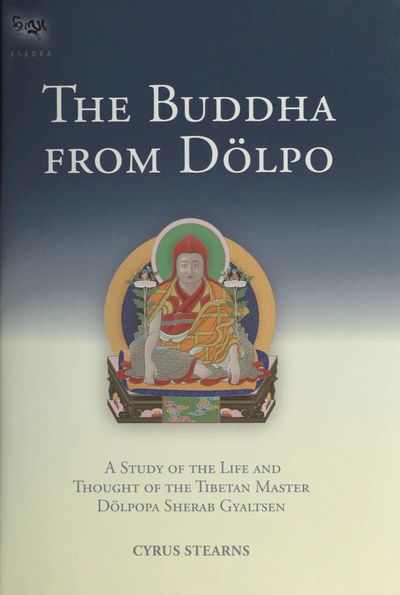No edit summary |
No edit summary |
||
| (10 intermediate revisions by 4 users not shown) | |||
| Line 1: | Line 1: | ||
{{Book | {{Book | ||
|BookPerson={{Book-person | |BookPerson={{Book-person | ||
|PersonPage=Dol po pa | |||
|PersonName=Dölpopa Sherab Gyaltsen | |||
}}{{Book-person | |||
|PersonPage=Stearns, C. | |PersonPage=Stearns, C. | ||
|PersonName=Cyrus Stearns | |PersonName=Cyrus Stearns | ||
| Line 11: | Line 14: | ||
* {{i|Introduction| 1}} | * {{i|Introduction| 1}} | ||
* | * PART ONE: ''The Life and Teachings of the Omniscient Dölpopa'' | ||
* {{i|Chapter One: The Life of the Buddha from Dölpo| 9}} | * {{i|Chapter One: The Life of the Buddha from Dölpo| 9}} | ||
** {{i|1. Childhood and Early Education| 10}} | ** {{i|1. Childhood and Early Education| 10}} | ||
| Line 18: | Line 21: | ||
** {{i|4. Raising Mount Meru and Revealing the ''Shentong'' View | 19}} | ** {{i|4. Raising Mount Meru and Revealing the ''Shentong'' View | 19}} | ||
** {{i|5. The Initial Reception of the ''Shentong'' Teachings | 22}} | ** {{i|5. The Initial Reception of the ''Shentong'' Teachings | 22}} | ||
** {{i|6. The New Jonang Translation of the ''Kālacakra Tantra'' and the ''Stainless Light''| 24}} | ** {{i|6. The New Jonang Translation of the ''Kālacakra Tantra'' and the ''Stainless<br> Light''|24}} | ||
** {{i|7. Years of Retreat and Teaching |29}} | ** {{i|7. Years of Retreat and Teaching |29}} | ||
** {{i|8. Invitation to China by the Yüan Emperor Toghon Temür |29}} | ** {{i|8. Invitation to China by the Yüan Emperor Toghon Temür |29}} | ||
** {{i|9. Changes in the Jonang Leadership and the Beginning of the Journey to Lhasa| 31}} | ** {{i|9. Changes in the Jonang Leadership and the Beginning of the Journey to<br> Lhasa|31}} | ||
** {{i|10. Teachings in Central Tibet and the Return to Tsang| 33}} | ** {{i|10. Teachings in Central Tibet and the Return to Tsang| 33}} | ||
** {{i|11. The Aborted Meeting with Butön Rinchen Drup| 35}} | ** {{i|11. The Aborted Meeting with Butön Rinchen Drup| 35}} | ||
| Line 33: | Line 36: | ||
** {{i|2. A Redefinition of Cittamātra and Madhyamaka| 91}} | ** {{i|2. A Redefinition of Cittamātra and Madhyamaka| 91}} | ||
** {{i|3. Two Approaches to Enlightenment| 103}} | ** {{i|3. Two Approaches to Enlightenment| 103}} | ||
* | |||
* PART TWO: ''Texts in Translation'' | |||
* {{i|Introduction to the ''General Commentary on the Doctrine''| 113}} | * {{i|Introduction to the ''General Commentary on the Doctrine''| 113}} | ||
* {{i|1. Supplication Entitled ''General Commentary on the Doctrine''| 119}} | * {{i|1. Supplication Entitled ''General Commentary on the Doctrine''| 119}} | ||
* {{i|Introduction to the ''Fourth Council'' and the ''Autocommentary to the "Fourth Council" | * {{i|Introduction to the ''Fourth Council'' and the ''Autocommentary to the<br>"Fourth Council"''|131}} | ||
* {{i|2. ''Great Calculation of the Doctrine That Has the Significance of a Fourth Council''| 135}} | * {{i|2. ''Great Calculation of the Doctrine That Has the Significance of a Fourth Council''| 135}} | ||
* {{i|3. ''Autocommentary to the "Fourth Council" | * {{i|3. ''Autocommentary to the "Fourth Council"''|205}} | ||
* {{i|Notes |313}} | * {{i|Notes |313}} | ||
* {{i|Bibliography| 413}} | * {{i|Bibliography| 413}} | ||
| Line 44: | Line 48: | ||
|AddRelatedTab=No | |AddRelatedTab=No | ||
|QuotesTabContent={{GetBookQuotes}} | |QuotesTabContent={{GetBookQuotes}} | ||
| | |ExtraCategories=Tsadra Foundation Series | ||
|StopPersonRedirects=No | |||
}} | }} | ||
Latest revision as of 16:47, 6 August 2020
The Buddha from Dölpo is a revised and enlarged edition of the only book about the most controversial Buddhist master in the history of Tibet, Dölpopa Sherab Gyaltsen (1292-1361), who became perhaps the greatest Tibetan expert of the Kālacakra, or Wheel of Time, a vast system of tantric teachings. Based largely on esoteric Buddhist knowledge from the legendary land of Shambhala, Dölpopa's insights have profoundly influenced the development of Tibetan Buddhism for more than 650 years.
Dölpopa emphasized two contrasting definitions of the Buddhist theory of emptiness. He described relative phenomena as "empty of self-nature," but absolute reality as only "empty of other," i.e., relative phenomena. He further identified absolute reality as the buddha nature, or eternal essence, present in all living beings. This view of an "emptiness of other," know in Tibetan as shentong, is Dölpopa's enduring legacy.
The Buddha from Dölpo contains the only English translation of three of Dölpopa's crucial works. A General Commentary on the Doctrine is one of the earliest texts in which he systematically presented his view of the entire Buddhist path to enlightenment. The Fourth Council and its Autocommentary (which was not in the first edition of this book) were written at the end of his life and represent a final summation of his teachings. These translations are preceded by a detailed discussion of Dölpopa's life, his revolutionary ideas, earlier precedents for the shentongview, his unique use of language, and the influence of his theories. The fate of his Jonang tradition, which was censored by the central Tibetan government in the seventeenth century but still survives, is also examined. (Source: Shambhala Publications)
| Citation | Stearns, Cyrus. The Buddha From Dolpo: A Study of the Life and Thought of the Tibetan Master Dolpopa Sherab Gyaltsen. Tsadra Foundation Series. Ithaca, NY: Snow Lion Publications, 2010. First published 1999 by State University of New York Press. |
|---|---|


